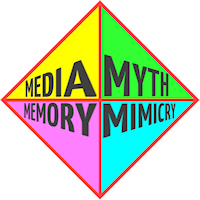These four M’s are views to analyse religions from. Just as you see different things about the same building if you walk around to different view spots, so you can with religions.
 We use four views, like a prism. On their own, none of these give the complete view. From four different angles though, it helps things make sense.
We use four views, like a prism. On their own, none of these give the complete view. From four different angles though, it helps things make sense.
And you can use this method for any religion. The 4M view helps us understand what is going on in Islam and Christianity today, especially in these parallel dechurched and demosqued movements.
Here’s a short story to illustrate the weaving of these 4 Ms into a religion.
The priest and the printer
On October 31st 2017 Protestantism celebrated five hundred years of existence. On that day in 1517, Martin Luther nailed his famous thesis against the Roman Catholics on the Wittenberg church door in Germany, and the rest, as they say, is history.
Or was it?
Mythologies about this break from the Pope exist amongst Protestants and Catholics to this day. Some Roman Catholics list theirs on the internet, under headings like ‘Ten myths Protestants believe’. That ten nearly always includes; Protestants think Catholics worship Mary; Catholics added books to the Bible. In turn many Protestants are sure the Catholics represent the ‘whore from Babylon’ referred to in the scriptures.
In recent times, historians have entered the fray, and drawn a connection with the printing press. It was indeed opportune the technology had been invented to mass produce the holy text as factory printed media by the sixteenth century. After all, Protestants revere the Bible way above any human being, and especially the Pope. Printing the Bible in common English bypassed the clergy, enabling individuals to read it themselves and discover the ‘truth about Rome’.
A recent theory has it all starting around a church fund raising drive, not an uncommon event in any community. True, selling tickets to avoid perdition was a little off beam, but if Hell Pizza ever picked the idea back up today, it’d probably be a best seller. Buying an ‘Indulgence’ enabled believers to earn divine credit, perhaps even ahead of spending it on a sin. I realise there is a whole genre of humor here, and the reader can search the Monty Python film archives if they like.
However, matters were more serious 500 years back. Being burnt at the stake, or disemboweled after you’ve been nearly hung was still in vogue – that’s right, you choke until the last second, then they lower you down for phase two. Luther was taking a serious risk. Nobody denies that.
It was the explosive expansion of the sale of Indulgences that drove him to complain. Prior to the printing press, such documents were handwritten by priests. There was no cramped industrial complex full of men of the cloth, working around the clock writing out Indulgences. Production was quite limited in fact.
Enter the printing press, and the replication problem was solved. Gutenberg himself printed thousands of Indulgences in one of the few profitable ventures he undertook, but only about 180 Bibles. As it happened, the Roman Catholic church never formally approved the sale of Indulgences. Had it been restricted to the domain of hand printing, the issue might not have generated the foment it did.
Technological advances produce unplanned outcomes. Who would have thought a printer could lead to a new worldwide religion? Firstly it annoyed at least one priest enough with its ability to replicate iniquity, then provided the means to avoid an ordained leader on earth. The very mantra of Protestants informs us – sola scriptura – which means a sole reliance on scripture. And how do you get scripture out to the masses?
You require a printing press.
It posed a challenge elsewhere too.
The first Qu’ran was printed by Venetians in 1537 thinking they had a market to the east, in the Ottoman Empire. Unfortunately for them, they didn’t test the market first. This then center of Islamic power prohibited printing in Arabic. The language was that of Allah according to Muslims, and was therefore due more respect than a machine. Islamic legal scholars and the manuscript scribes outlawed printing of the Qu’ran up until 1726, initially on pain of death. It took the obvious and growing power of Europe to convince the Grand Mufti, and the Muslim clergy, on the efficiency of the printing press.
My own copy of the Qu’ran was produced in collaboration with Saheeh International in Saudi Arabia, who perform ‘Professional Editing and Typesetting of Islamic Literature’. This Qu’ran, with Arabic neatly alongside an English version, was given to me. It boldly states on the cover that it is a ‘Gift Not For Sale.’ I wonder if Saheeh International mimicked The Gideons International who since their inception in 1899 have given away 1.8 billion Bibles around the world.
There. Within a single page we’ve got a case study.
Mythology.
Media.
Mimicry.
And the weaving of these two religions together like that is only possible due to everything we’ve remembered. So far we humans think that transmitted memories are the sole domain of we humans. Let’s not debate about elephants and dolphins right now, the point being that over millennia, mankind grew clever at storing and recalling memory through media devices such as books, the internet, and movies.
My advice?
